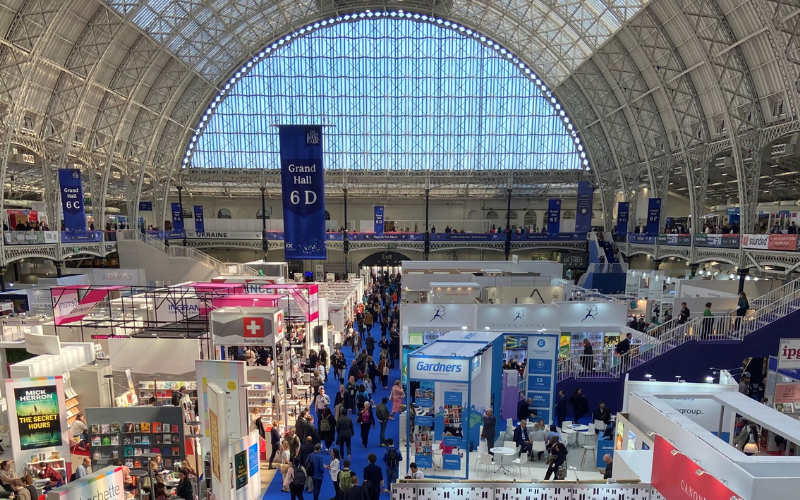A Day at the (London Book) Fair, 19 April 2023
Last year’s London Book Fair (LBF) was not a great experience for many: the building works outside Olympia were noisy and disruptive; there were long queues to enter, as everyone had to show their Fair and covid passes; and a large percentage of attendees caught coronavirus after being stuck indoors for three days. Visitor numbers were down 10,000 or 40% on the last live event, in 2019.
In some ways, that made for a calmer LBF, one where you could walk down the aisles between stands without being jostled, and where grabbing a coffee or sandwich didn’t require a 15-minute wait.
This year, entrance on Wednesday morning was quick, although the first day was busy with the usual long queues. Works to turn Olympia into a cultural hub continue, with five enormous cranes towering over the venue, building a new music arena and theatre, along with hotels and a performing-arts school.
After a quiet start, people poured into the corridors and stands from mid-morning onwards. By the afternoon, the spring sunshine was doing its best to bake exhibitors and visitors on one of the nicest days of the year.
The Academic & Professional Hall was not busy. Cambridge University Press decided not to take a stand, and its rivals such as Oxford University Press didn’t look overwhelmed with visitors. The Trade Hall was full, with busy tables on most stands. All the free seminar events were extremely well attended, with many having to squat on the floor or stand outside the talks area to hear the speakers.
Themes of the Fair
The free talks programme was bigger and wider ranging than in previous years. Diversity, Equality and Inclusion (DEI) was a key theme. Panels covered both how to recruit and retain a wider range of talent than has traditionally staffed publishing houses, and how to widen the range of books published. Kate Wilson, MD and Founder of Nosy Crow, who is opening a new US office, pointed out that 33% of London children don’t identify as ‘white’, a figure that rises to 55% in the US. Their first US/UK title is also being published simultaneously in Spanish, to cater for the Latinx audience in the US.
Suzy Astbury, MD of recruiters Inspired Selection, encouraged those trying to get into the publishing industry to think beyond traditional editorial roles, or the ‘Big Five’ companies. With 75% of candidates after editorial roles in adult trade fiction, it’s worth applying to other roles in production, marketing, rights and sales, and remembering other sectors in which books and content are published, such as Academic, Educational and Professional.
Another area under discussion was the influence of artificial intelligence (AI), a catch-all term that US literary agent Ethan Ellenberg said had become ‘meaningless’, as people were using it to cover everything and anything. The most interesting and potentially useful tools now widely available are Chat GPT and other writing programs. These could revolutionise publishing and are already having an impact. Not only for the content they can provide, but also marketing copy and commercial plans, as you can ask the programs to produce a business plan or an advertising campaign. All the speakers I heard welcomed this new technology as an ‘opportunity’ rather than a threat. Joanna Penn, a prolific and successful self-published writer, loved the possibilities it presented, and described herself as an ‘AI-assisted, artisan author’.
Money and salaries were another concern, with many arguing for better pay rates, particularly in the big cities where monthly rent can average £830 (London) or $4,000/£3,215 (New York). No wonder HarperCollins staff were striking because they said they could not live on a $45,000 starting salary with rents like that! (For the uninitiated, US salaries are always much bigger than UK ones. When I asked one of my bosses about this years ago, I was told that’s just how it was – US colleagues worked longer hours, had fewer paid holidays and/or sick days and benefits, and were paid more. I’m still not entirely sure I get the argument.)
The overall atmosphere of the Fair was upbeat. It felt very international, with countries, foreign book fairs and international publishers taking over an increasing percentage of overall floor space. One consequence of there being fewer big, splashy promotional areas for specific titles is that there aren’t so many places to sit for those without a stand. I have fond memories of having a coffee in a large comfy chair in an area to promote a new Ruby Wax title, pre-covid. Even the Ivy at the LBF has gone. Lots of people sit on the floor to talk, eat their lunch or have a drink. I miss the pop-up spaces, mostly because of my ageing knees, although it’s good if the money’s being spent elsewhere.



Petra Green
Petra Green is Head of the PTC and a freelance publishing consultant. Follow her on LinkedIn.